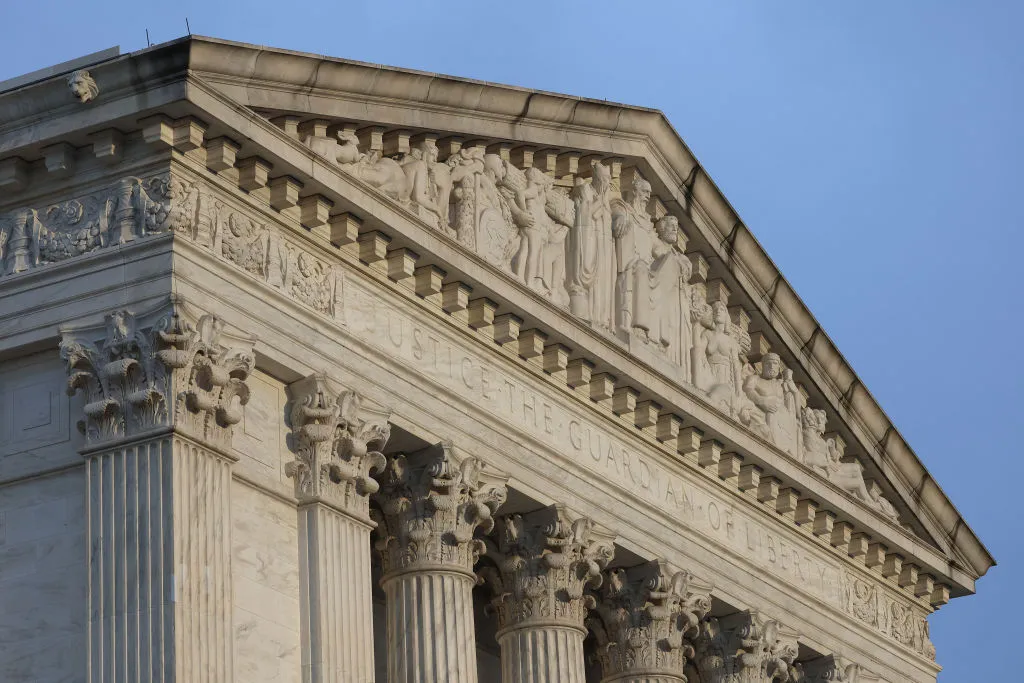Empirical SCOTUS is a recurring sequence by Adam Feldman that appears at Supreme Courtroom knowledge, primarily within the type of opinions and oral arguments, to offer insights into the justices’ determination making and what we will count on from the courtroom sooner or later.
On Monday, Oct. 6, the primary day of the Supreme Courtroom’s 2025-26 time period, in addition to the twentieth anniversary of Chief Justice John Roberts’ tenure, it felt applicable to ask: Who really runs the Supreme Courtroom?
Former Justice Felix Frankfurter insisted the reply was “nobody.” “Except for the ability to assign the writing of opinions … a Chief Justice has no authority that every other member of the Courtroom hasn’t … The Chief Justice is primus inter pares [first among equals]. He presides … in Courtroom and at convention.”
That’s the civics-book reality: 9 life-tenured judges, every a sovereign vote, no formal boss. Former Chief Justice William Rehnquist, the chief previous to John Roberts, said much the same: the chief’s vote “carries no extra weight” than that of every other justice, and any hope {that a} skillful administrator will “carry the Courtroom collectively” is usually fantasy. In response to Rehnquist, the chief presides over eight “associates … as unbiased as hogs on ice. He could at most persuade or cajole them.”
But persuasion and cajoling matter – particularly in a world the place the individual within the center can, if within the majority, resolve who writes the opinion that everybody else should signal. That’s the place the workplace turns into one thing greater than a ceremonial gavel. As my buddy Dan Cotter places it in his ebook “The Chief Justices,” a profitable chief “has the power to be a superior amongst his equals,” utilizing the job’s quiet levers to form the courtroom’s picture and legacy. The levers aren’t hidden: preside at convention, body the questions, assign the bulk when within the majority, and – at vital moments – choose up the pen.
This text takes Frankfurter and Rehnquist’s warning severely and checks Cotter’s declare with knowledge. Utilizing the Supreme Court Database, it tracks three issues you possibly can really observe throughout the 5 fashionable chief-justice eras – Fred Vinson, Earl Warren, Warren Burger, Rehnquist, Roberts: (1) whether or not the courtroom speaks with one voice (consensus); (2) how the chief manages shut instances (management); and (3) how typically doctrine really strikes (impression).
Consensus
Unanimity is the clearest strategy to see actual settlement on the Supreme Courtroom as a result of it collapses the 2 issues that often get pulled aside – end result and reasoning – right into a single sign. When each justice indicators onto the judgment and the opinion, the courtroom isn’t simply asserting who gained; it’s talking with a typical authorized voice about why. That provides attorneys and decrease courts a rule they’ll comply with with out guessing which concurrence controls or how you can add up fractured rationales.
Unanimity additionally carries legitimacy. A unified courtroom appears to be like much less like a set of camps and extra like an establishment delivering a rule of determination. Unanimity can also be easy to measure and examine throughout eras. It’s the most conservative take a look at of consensus: If the courtroom can get all the best way to a excessive stage of consensus, that may be a qualitatively totally different form of settlement than a naked majority or a fractured alignment.
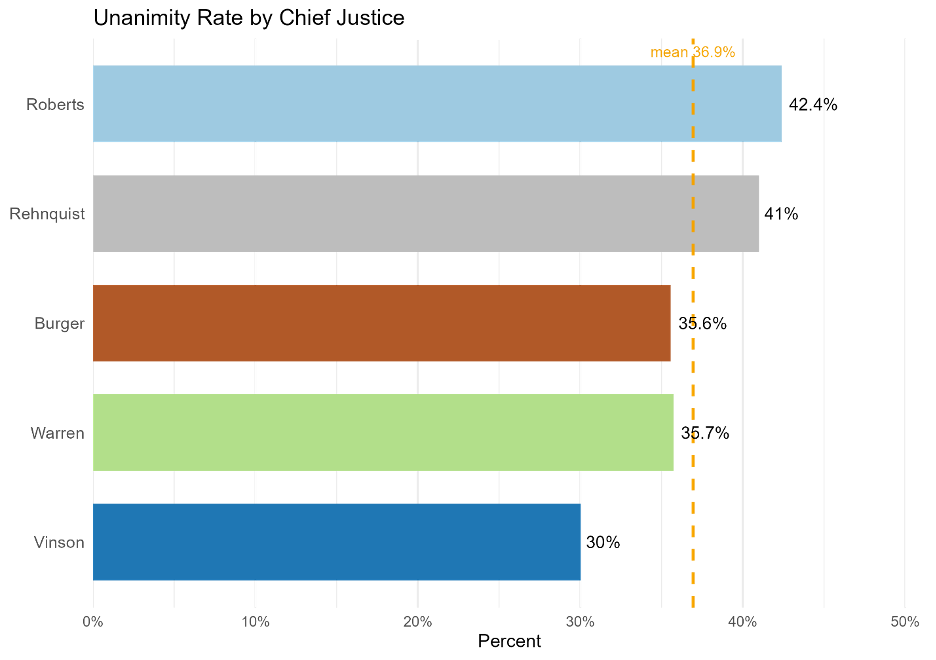
Because the chart illustrates, unanimous rulings have grow to be extra frequent over time. Below Vinson, roughly three in 10 choices had been unanimous; that share climbed within the Warren and Burger Courts to the mid-thirties, reached about 41% below Rehnquist, and sits at roughly 42% within the Roberts period. Learn plainly, that may be a regular drift towards extra settlement over time.
None of this implies the instances are small. A unanimous determination can reset nationwide follow simply as certainly as a 5–4 determination can. What it does imply is that the courtroom typically prefers to settle battle with as a lot buy-in as doable, even when which means deciding lower than the events requested for. The image that emerges throughout chiefs is constant: a courtroom that also divides on loads of high-profile points, however that additionally, with rising frequency, finds frequent floor to resolve the regulation.
Management
By customized, the chief assigns the opinion when within the majority. This graph exhibits how typically, in 5–4 instances, the project got here from the chief, or put one other means, the frequency with which the chief was within the majority in these instances.
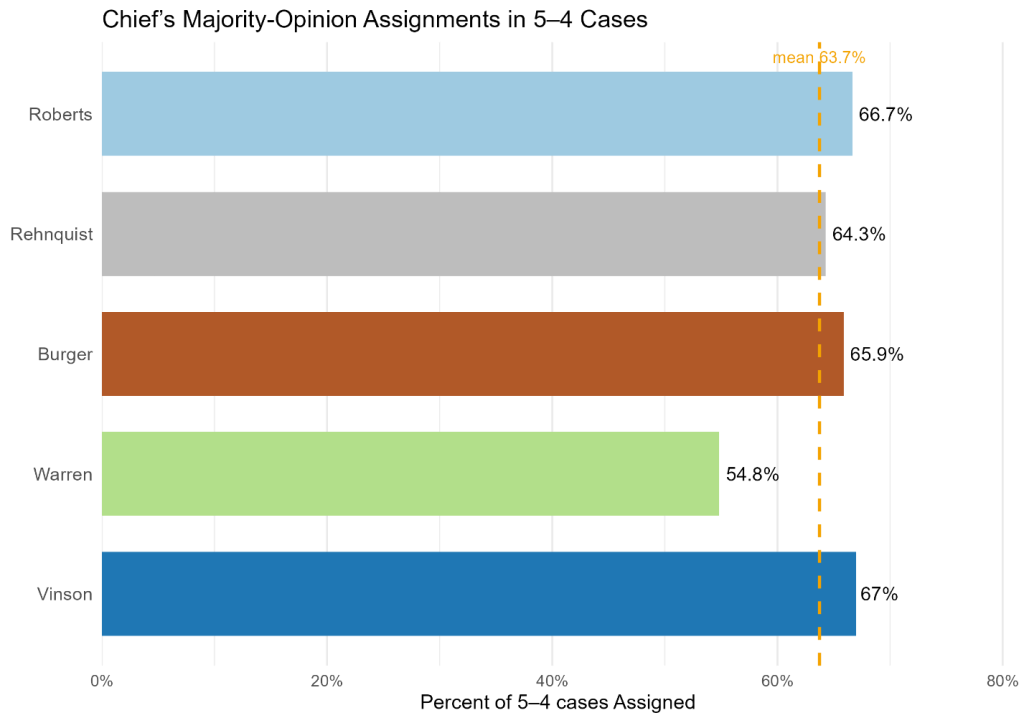
Chiefs are likely to preserve a big share of 5–4 assignments: Vinson 67%, Warren 54.8%, Burger 65.9%, Rehnquist 64.3%, Roberts 66.7% (amongst instances with a identified assigner). That sample suggests robust central steering within the closest instances, with Warren the outlier on the low aspect and the others clustered round two-thirds.
The subsequent graph focuses on the chief’s authorship charge in one-vote instances. These are managerial decisions. Place the opinion with the suitable creator and you retain your fifth vote; take the pen your self and you may dictate the language with the acceptance of the bulk coalition.
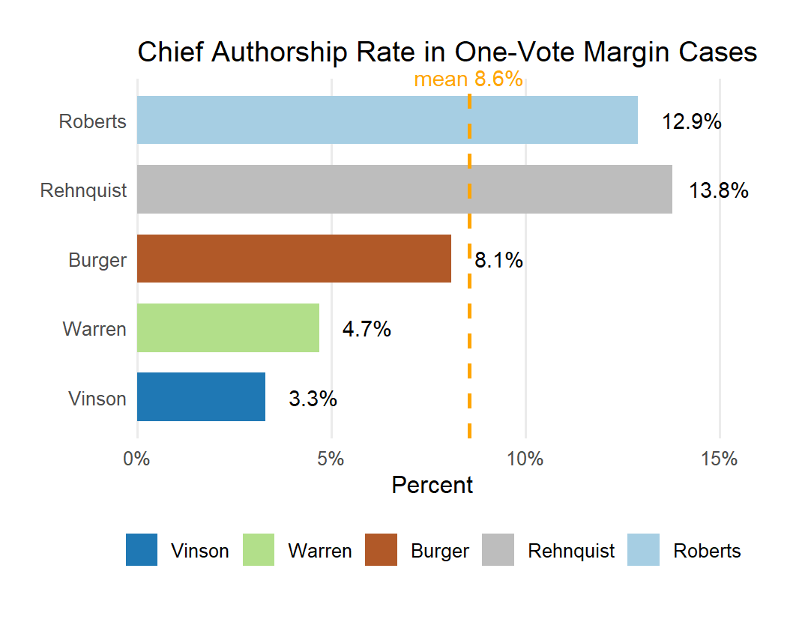
Rehnquist and Roberts each present assertive project in 5–4s by authoring a significant share of these one-vote choices. That’s what management appears to be like like when vote splits are shut: you don’t win each divided case, however you form those you win. Put one other means, Rehnquist after which Roberts had been the justices most in a position to not solely command 5-4 majorities, however to creator the opinions whereas holding collectively coalitions in typically essentially the most consequential and coveted authorship choices.
Affect
Affect could be seen as a measure of change. This underlies the idea of aggressive grants and why the justices reverse choices extra typically than they’re overturned. The notion of impression as associated to vary doesn’t relate to any normative claims on my half about the advantages of impression however does sign authorized change made by the courtroom.
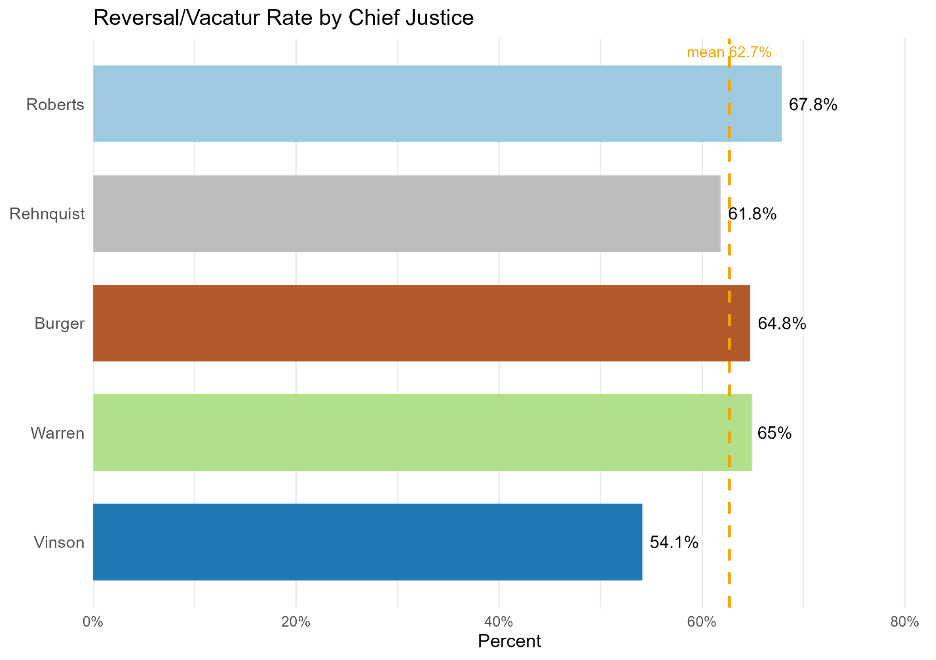
Wanting throughout the final 5 chief justices, the Supreme Courtroom often overturns the decrease courtroom within the instances it decides: about 54% of the time below Vinson, 65% below Warren, 65% below Burger, 62% below Rehnquist, and about 68% below Roberts – roughly two out of three choices as we speak. In contrast, overruling precedent is uncommon in each period and remarkably regular, sitting round 2–3% of choices (about 1.7% below Vinson, 2.6% Warren, 2.3% Burger, 2.4% Rehnquist, 2.2% Roberts). In brief: frequent reversals of decrease courts however only a few outright adjustments to the courtroom’s personal previous choices.
An index
Primarily based on the above, I constructed the composite scores beneath from the coding within the Supreme Courtroom Database (extra methodological particulars can be found at Legalytics).
- Consensus: Share of unanimous choices
- Management: Fee of when the chief was within the majority in divided instances, project charge (all instances), project charge in 5–4 choices, and authorship in one-vote instances
- Affect: Precedent alteration and reversal of the decrease courtroom choices
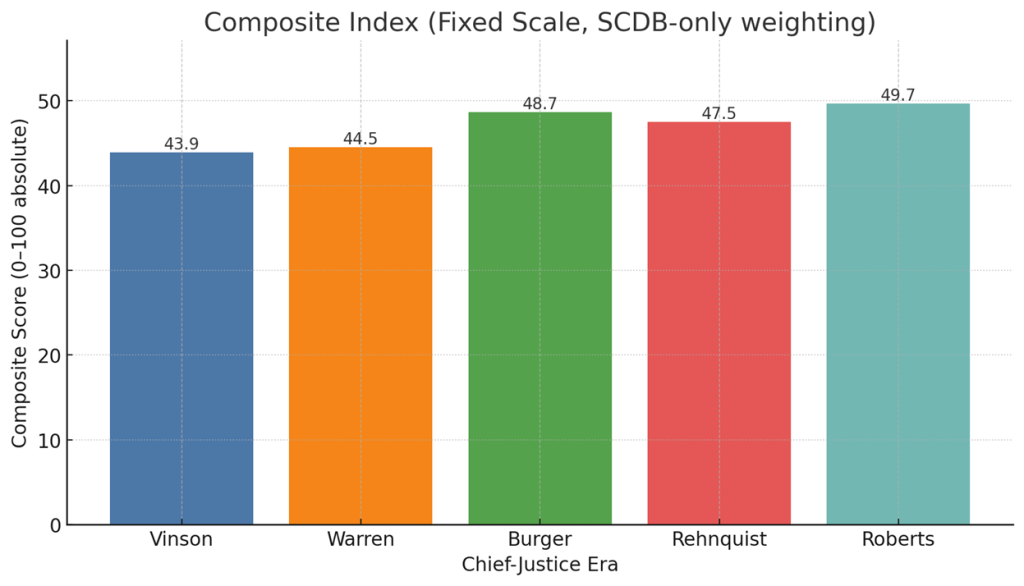
The bars report each chief-justice era’s composite score. On this scale, Roberts sits at the top of the group, followed closely by Burger and Rehnquist, with Warren and Vinson a bit lower.
A lasting picture
The Guardian recently quoted former decide and Roberts buddy J. Michael Luttig: “John Roberts is aware of precisely what he’s doing … and he is aware of precisely the message he’s sending to America.” The piece describes a chief with disciplined self-awareness who cares deeply concerning the courtroom’s public picture. His consideration to element is known; he rehearses questions and even fine-tunes jokes earlier than argument. “He speaks so easily – and disguises his inside convictions so totally – that he has been in a position to straddle political and private divides.” That public craft matches the managerial traces the information depart behind on his twentieth anniversary on the bench: a chief who values consensus, chooses his moments to take the pen, and retains the establishment’s voice regular even when the docket’s edges are sharp.
That managerial profile is strictly what the composite index is designed to detect. Roberts tops it not as a result of he’s essentially the most transformative – Warren’s period nonetheless registers the biggest formal doctrinal shifts – however as a result of he combines the best unanimity with focused management of shut instances. He’s ceaselessly within the majority when the courtroom divides, he assigns strategically in 5–4 instances, and he authors when it preserves the coalition.
However what concerning the greater image? Frankfurter and Rehnquist had been proper concerning the limits: the chief is one vote, not a boss. However Cotter’s “superior amongst equals” is seen within the traces a chief leaves behind – how typically the courtroom speaks with one voice, who authors when the case is shut, and whether or not doctrine really strikes. As described, these are managerial decisions, they usually range throughout eras in methods the figures make plain: Warren as architect of change, Rehnquist as supervisor of shut instances, Roberts as coalition-builder with a gradual hand on assignments.
In fact, none of this resolves the normative fights about outcomes. Nevertheless it does give us a good, repeatable strategy to decide how every chief used the workplace – how persuasion, not command, turned choices that decrease courts should comply with. If first amongst equals means something on the Supreme Courtroom, that’s the place it resides.
Really useful Quotation:
Adam Feldman,
Rating the fashionable chief justices,
SCOTUSblog (Oct. 6, 2025, 9:30 AM),
https://www.scotusblog.com/2025/10/ranking-the-modern-chief-justices/
